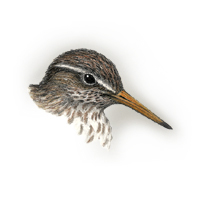 |
Spotted Sandpiper
Actitis macularia |
|
|
STANFORD LOCATIONS: Occasional spring visitor to Lagunita, foraging on mud as the lake recedes. |
 |
Location |
Type |
Mating System |
Parental Care |
2ndary Diet |
Strategy |
|
|
|
|
I: 20-24 DAYS PRECOCIAL 2 |
|
|
|
|
(1-4) POLYAND |
M |
..... INVERTE- .... BRATES |
| BREEDING: | Wide variety of habitats: semiopen veg from sea level to alpine near water. Usu 2-3, exceptionally to 5 broods. |
| DISPLAYS: | See: Shorebird Communication. |
| NEST: | Elevated site in grass, among rocks, within moss, forbs, shrubs, tangle on slope, in wooded areas near log, etc. Bulkier in n. Of dry moss, lined with grass, moss, occ feathers. |
| EGGS: | Brownish/greenish/pinkish-buff, marked with dark brown. 1.3" (32 mm). |
| DIET: | Largely flying insects, also worms, fish, crustaceans, mollusks, carrion. Deftly captures flying insects; also picks from water's surface. |
| CONSERVATION: | Winters s to n Chile, n Argentina, Uruguay. |
| NOTES: | Usu nests solitary, occ loosely colonial. Polyandrous females arrive before males on breeding grounds; males also defend territories. Experienced females have more mates, and produce more eggs, chicks, and fledglings than inexperienced females. Female lays up to 5 complete clutches; male provides most or all care for only a single nest and brood. Most consistent source of egg loss in 10-yr MN study was mice. Constantly bobs and teeters on ground. Can swim, dive, perch on wires. Roosts in loose flocks. |
| ESSAYS: | Polyandry in Spotted Sandpiper; Polyandry; Mice and Ground-nesting Birds; Spacing of Wintering Shorebirds. |
| REFERENCES: | Cramp and Simmons, 1983; Oring et al., 1983. |
| Help | Abbreviations | Species-Alphabetical | Species-Taxonomic | Essays-Alphabetical | |
| Except for Stanford Locations, the material in this species treatment is taken, with permission, from The Birder's Handbook (Paul Ehrlich, David Dobkin, & Darryl Wheye, Simon & Schuster, NY. 1988). | |||||